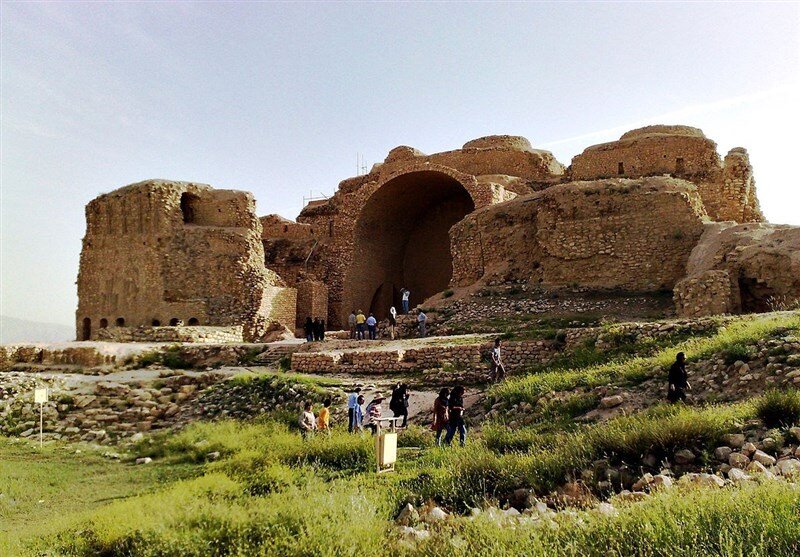UNESCO-listed Sassanian landscape to undergo restoration

TEHRAN – Fars’s tourism chief has announced plans to restore the UNESCO-registered Sassanid Archaeological Landscape, which is situated in the southern Iranian province.
Mohammad Sabet-Eqlidi publicized the scheme in a familiarization tour of the iconic Qal’eh Dokhtar and Palace of Ardashir, two integral components of this historical ensemble, organized for journalists from Iran and abroad.
Speaking on the sidelines of the journalists’ visit to the ancient sites in Firuzabad, Sabet-Eqlidi highlighted the significance of recent initiatives to organize, renovate, and conserve these historical landmarks.
The official emphasized that beyond mere maintenance, the Sassanid Archaeological Landscape requires rigorous protection.
In 2018, the UN cultural body added an ensemble of Sassanian historical cities in southern Iran — titled “Sassanid Archaeological Landscape of Fars Region”-- to its World Heritage list. The ensemble comprises eight selected archaeological site components in three geographical contexts: Firuzabad, Bishapur, and Sarvestan.
Detailing the forthcoming restorations, Sabet-Eqlidi outlined a three-phase approach. The first phase involves de-cluttering and revitalizing the worn-out furnishings to enhance the aesthetic appeal and integrity of the landscape.
“Subsequently, the second phase will focus on organizing administrative and residential spaces, followed by the third phase, which will entail designing accessible pathways to the heritage sites,” he added.
Furthermore, Sabet-Eqlidi pointed out specific enhancements, including the construction of a new prayer hall, the repair of cable cars, and the establishment of sanitary facilities near the historical complex of Qal’eh Dokhtar. He underscored efforts to ensure architectural consistency between restoration works and the original design of these sites.
Expressing satisfaction with the progress, particularly in the repair of cable cars, Sabet-Eqlidi noted that expedited access for maintenance workers has been facilitated.
Elsewhere in his remarks, the official praised the implementation of top-tier lighting systems at the Qal’eh Dokhtar historical site in Firuzabad. Moreover, he revealed plans to extend this lighting scheme to illuminate the adjacent mountain, enhancing the visual spectacle of the historical landmark.
Sabet-Eqlidi reaffirmed the commitment to preserving and showcasing the cultural heritage of Fars Province, inviting local and international visitors to experience the rich historical legacy of the Sassanid era.
The property includes fortification structures, palaces, reliefs, and city remains dating back to the earliest and latest periods of the Sassanid Empire, which extended across the region from 224 to 651 CE. Among the sites are the military headquarters and first capital of the dynasty founder Ardashir Papakan, and a city with architectural structures of his successor, the ruler Shapur I. In Sarvestan, a monument dating to the Early Islamic period illustrates the transition from the Sassanid to the Islamic era.
The ancient cities of Ardashir Khurreh and Bishapur contain the most significant remaining testimonies of the earliest periods of the Sassanid Empire, marking the beginnings of Ardashir I and the consolidation of power under both Ardashir I and his successor Shapur I. Strategically chosen for defense, these cities were carefully planned within their surrounding environments and exemplify urban typologies, such as the circular shape of Ardashir Khurreh, which influenced later Sassanid and Islamic cities. The surrounding landscape bears Sassanid testimonies, including reliefs and sculptures carved into rock cliffs and defensive structures guarding the cities. The architecture of the Sassanid monuments in the property further showcases early examples of dome construction with squinches on square spaces, as seen in the Chahar-taq buildings, where the four sides of the square room feature arched openings. This architectural style became the hallmark of Sassanid religious architecture, closely tied to the promotion and stabilization of Zoroastrianism during Sassanid rule and continuing into the Islamic era through its use in religious and sacred buildings such as mosques and tombs.
AM
Leave a Comment